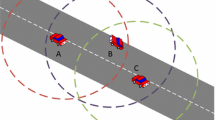Abstract
IEEE 802.11 Medium Access Control (MAC) is proposed to support asynchronous and time bounded delivery of radio packets. Distributed Coordination Function (DCF), which uses Carrier Sense Multiple Access with Collision Avoidance (CSMA/CA) and binary slotted exponential backoff, is the basis of the 802.11 MAC. This paper proposes a throughput enhancement for DCF by adjusting the Contention Window (CW) setting scheme. Moreover, an, analytical model based on Markov chain is introduced to compute the enhanced throughput. The accuracy of the model and the enhancement of the proposed scheme are verified by elaborate simulations.
Similar content being viewed by others
References
IEEE standard for Wireless LAN Medium Access Control (MAC) and Physical Layer (PHY) Specifications. ISO/IEC 8802-11:1999 (E), Aug. 1999.
Crow B P, Kim J G. IEEE 802.11 wireless local area networks.IEEE Comm. Magazine. Sept. 1997, 35(9): 116–126.
Nee R, Awater G. New high-rate wireless LAN standards.IEEE Comm. Magazine, Dec. 1999, 37(12): 82–88.
Anastasi G, Lenzini L. QoS provided by IEEE 802.11 wireless LAN to advanced data applications A simulation analysis.Wireless Networks, 2000, 6(2): 99–108.
Ho T, Chen K. Performance analysis of IEEE 802.11 CSMA/CA medium access control protocol. InProc. PIMRC, Taipei, Oct. 1996, pp.407–411.
Bianchi G. Fratta L, Oliveri M. Performance evaluation and enhancement of the CSMA/CA MAC protocol for 802.11 wireless LANs. InProc. PIMRC, Taipei, Oct. 1996, pp.392–396.
Chhaya H S, Gupta S. Performance modeling of asynchronous data transfer methods of IEEE 802.11 MAC protocol.Wireless Networks, 1997, 3: 217–234
Cali F, Conti M, Gregori E. Dynamic tuning of the IEEE 802.11 protocol to achieve a theoretical throughput limit.IEEE/ACM Trans. Networking, Dec. 2000, 8(6): 785–799.
Bianchi G. Performance analysis of the IEEE 802.11 distributed coordination function.IEEE Journal on Selected Area in Comm., March 2000, 18(3): 535–547.
Wu Haitao, Peng Yong, Long Kepinget al. A simple model of IEEE 802.11 Wireless LAN. InProc. IEEE ICII'2001, Oct. 2001, pp.514–519.
Computer Networks (3rd Edition). Andrews Tanenbaum (eds.), Tsinghua University Publishing House, pp.282–283.
NS2. http://www-mash.cs.berkeley.edu/ns/
Author information
Authors and Affiliations
Corresponding author
Additional information
This work is supported by the National Research Foundation for the Doctoral Program of Higher Education of China, (Grant No.20010013003), the National Natural Science Foundation of China (Grant No.90204003) and NOKIA-BUPT Advanced TCP/IP Networks Project.
He is now in Microsoft Research Asia (MSRA)
WU HaiTao was born in 1976. He received his Ph.D. degree from the Beijing University of Posts and Telecommunications (BUPT) in 2003. He is currently a post-doctor in Microsoft Research Asia (MSRA). His research interests are IP QoS, TCP/IP, differentiated services, and wireless networks.
LIN Yu received the Ph.D. degree from the Beijing University of Posts and Telecommunications (BUPT) in 2003. He is currently a lecturer of the National Laboratory at BUPT. His current research interests cover Internet measurement and analysis, IP Qos and wireless networks.
CHENG ShiDuan is a professor and Ph.D. supervisor. She was born in 1940 and graduated from BUPT in 1963. From 1992 to 1998 she was the head of The Switching and Network Expert Group of 863 Program, a National High-Tech R&D Plan organized by The Ministry of Science and Technology of China. She has published more than 100 papers and several books in the field of telecommunications. Her research interests cover ISDN, ATM, protocol engineering, network performance, security and survivability.
PENG Yong was born in 1978 and received his B.S. degree in computer science from the BUPT in 1999. He is currently a Ph.D. candidate of the National Laboratory of Switching Technology and Telecommunication Networks at BUPT. His research interests are QoS and wireless networks.
LONG KePing was born in 1968 and received his Ph.D. degree in 1998 from University of Electronic Science Technology of China (UESTC). He is current a post-doctoral researcher and associate professor in BUPT. His research interests include SDH/ATM network survivability, ATM/IP network performance analysis, TCP enhancement, queue management and IP QoS. He has over 30 research publications.
Rights and permissions
About this article
Cite this article
Wu, H., Lin, Y., Cheng, S. et al. IEEE 802.11 Distributed Coordination Function: Enhancement and analysis. J. Comput. Sci. & Technol. 18, 607–614 (2003). https://doi.org/10.1007/BF02947120
Received:
Revised:
Issue Date:
DOI: https://doi.org/10.1007/BF02947120




